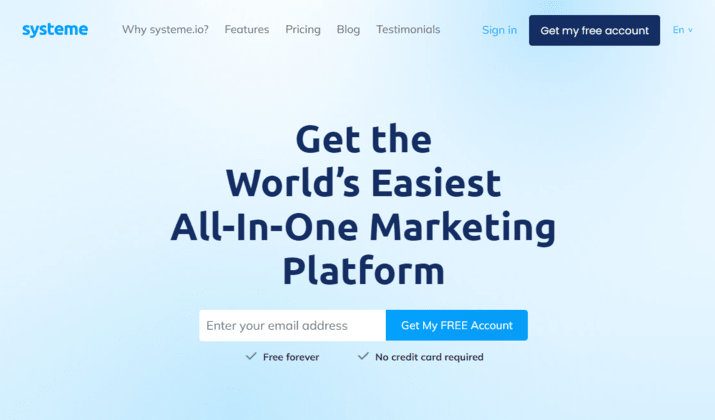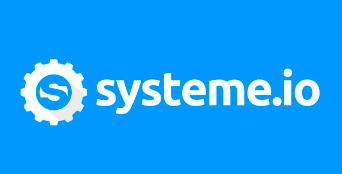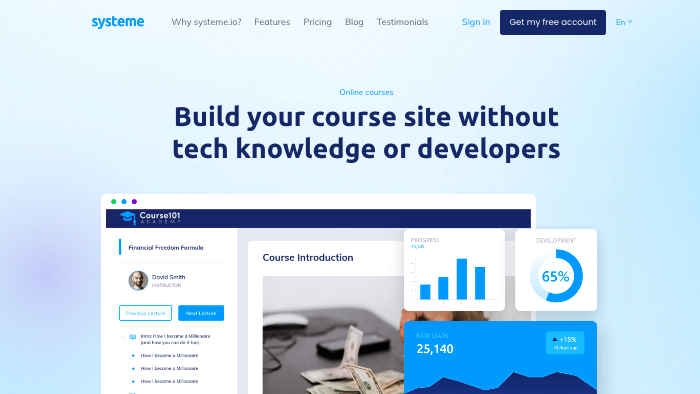Starting an online business and creating online courses has become increasingly popular in recent years.
Whether you’re an entrepreneur looking to monetize your expertise or a teacher wanting to reach a wider audience, having a reliable platform to host and manage your courses is essential.
Let’s hear a relatable story from Debby, an aspiring course creator, to set the stage for our discussion.
Debby has always had a passion for photography. She’s been capturing stunning images for years and has even taken a couple of photography courses herself.
Now, she wants to share her knowledge and help others improve their photography skills through her online courses.
Excited about this new venture, Debby starts researching course platforms that can support her business. During her search, she comes across Systeme.io and Kajabi.
Intrigued by the possibilities, she explores these platforms, hoping to find the perfect fit for her photography courses.
Take a look at what she finds out.
Also Read: Systeme.io vs Webflow
Systeme.io vs Kajabi – Overview & Features
Kajabi
Kajabi is an all-in-one platform designed for creating and hosting online courses, offering a comprehensive set of features to support course creators in building and growing their online businesses.
Some of the top features of Kajabi include:
- Website Builder: Kajabi provides an intuitive web builder application with drag-and-drop functionality, allowing users to easily customize their sites with a variety of themes and layouts.
- Blog Creation: Users can effortlessly create and manage blog posts, schedule future posts, add tags, and organize content within Kajabi.
- Custom Domains: Each Kajabi site is equipped with a custom domain name, enhancing brand identity and directing traffic to the website.
- Unlimited Hosting: Kajabi offers unlimited web and video hosting with all plans, ensuring users have ample storage space and bandwidth for their content.
- Email Marketing Automation: Kajabi includes tools for email marketing automation, allowing course creators to engage with their audience effectively.
- Membership Capabilities: Users can create membership sites, coaching programs, and various digital products beyond courses.
- Analytics: Kajabi provides detailed analytics reports to track student progress, revenue, subscriptions, and more, aiding in data-driven decision-making.
- CRM: The platform offers customer management software for triggering emails, promotions, and product access, helping users stay organized and informed about their customers.
- Mobile App: Kajabi’s mobile app enables users to access products on-the-go, providing convenience and flexibility for both creators and students.
- Built-In Integrations: Kajabi offers seamless integrations with other tools through platforms like Zapier, enhancing functionality and workflow efficiency.
These features collectively make Kajabi a versatile and powerful platform for course creators, entrepreneurs, and businesses looking to establish and grow their online presence and digital products effectively.
Systeme.io
Systeme.io is an online platform that offers a range of tools and features to help individuals launch, grow, and scale their online businesses effectively. Some of the top features of Systeme.io include:
- Sales Funnel Builder: Systeme.io provides a user-friendly sales funnel builder that allows users to create and customize sales funnels to optimize conversions.
- Email Marketing: The platform includes robust email marketing capabilities, such as workflow management, tagging, A/B testing, and one-click upsell, enabling users to engage with their audience effectively.
- Blogging Tool: Users can create and manage blogs within Systeme.io, allowing them to publish content, attract visitors, and enhance their online presence.
- Course Creator: Systeme.io offers a course creation feature, enabling users to develop and sell online courses to their audience.
- Affiliate Programs: The platform supports affiliate marketing by providing tools to manage affiliates, track sales, and pay commissions efficiently.
- Custom Domains: Users can connect custom domains to their Systeme.io sites, enhancing branding and credibility.
- Unlimited Email: Systeme.io offers unlimited email sending capabilities, allowing users to communicate with their subscribers without restrictions.
- Membership Site: Users can create membership sites with unlimited members, providing exclusive content and services to their subscribers.
- No Transaction Fees: Systeme.io does not charge transaction fees, allowing users to keep more of their revenue from sales.
- 24/7 Support: The platform provides 24/7 email support, a resource center with guides and tutorials, and a Facebook group for users to seek assistance and resources when needed.
These features collectively make Systeme.io a comprehensive and cost-effective solution for individuals looking to establish and manage their online businesses efficiently.
Not only does it caters to beginners, and entrepreneurs on a budget but all those seeking a user-friendly platform with essential tools for online success.
Sales funnels, email marketing, website builder, affiliate marketing, automation and more. With Systeme, get on top of your marketing!
Systeme.io vs Kajabi – Course Creation
In this section, we would understand how do we create courses on these platforms.
Kajabi
To create a course on Kajabi, you can follow these steps:
- Create Your Account: Begin by creating an account on Kajabi if you haven’t already done so. This step is essential to access the platform’s course creation tools.
- Plan Your Course Content: Outline the topics and content you want to include in your course. Having a clear plan will help you structure your course effectively and engage your audience.
- Access the Course Creation Tool: Once you have your account set up, navigate to the course creation tool on Kajabi. This tool will allow you to build and customize your course content.
- Design Course Modules and Lessons: Break down your course content into modules and lessons. Use Kajabi’s intuitive tools to add text, videos, quizzes, and other interactive elements to enhance the learning experience for your students.
- Set Up Membership and Pricing: Define the membership access levels for your course, whether it’s a one-time purchase, subscription-based, or free. Additionally, set the pricing for your course based on your business model and goals.
- Customize Course Settings: Customize the settings of your course, including drip content release, enrollment options, and any other preferences you have for how students interact with your course.
- Integrate Email Marketing: Utilize Kajabi’s email marketing tools to communicate with your students, send updates, promotions, and nurture relationships to enhance engagement and retention.
- Publish Your Course: Once you have set up your course content, structure, and settings, you can publish your course on Kajabi. Make sure to test the course to ensure everything works smoothly before making it available to students.
By following these steps, you can effectively create and launch your online course on Kajabi, leveraging its features and tools to deliver a high-quality learning experience to your audience.
Also Read: Stan Store vs Systeme.io
Systeme.io
To create a course on Systeme.io, the process involves several key steps as outlined below:
- Sign Up and Choose a Plan: Begin by signing up for an account on Systeme.io and selecting a suitable plan based on your needs, whether it’s the free plan or one of the paid options offering more features and capabilities.
- Access the Course Creation Tool: Once you have your account set up, navigate to the course creation tool within Systeme.io, where you can start building your online course.
- Design Your Course Structure: Outline the topics and content you want to cover in your course. Structuring your course content is crucial for creating a well-organized and engaging learning experience for your students.
- Create Course Modules and Lessons: Break down your course content into modules and lessons. You can use the platform’s intuitive tools to add text, images, videos, quizzes, and other interactive elements to enhance the learning experience.
- Set Up Membership Access: Define the access levels for your course, whether it’s a one-time purchase, a subscription model, or a free course. Systeme.io allows you to manage membership sites and control student access efficiently.
- Customize Course Settings: Customize the settings of your course, including pricing, enrollment options, drip content release, and any other preferences you have for how students interact with your course.
- Integrate Email Marketing: Utilize Systeme.io’s email marketing tools to communicate with your students, send updates, promotions, and nurture relationships to enhance engagement and retention.
- Publish and Launch Your Course: Once you have set up your course content, structure, and settings, you can publish and launch your course on Systeme.io. Make sure to test the course to ensure everything works smoothly before making it available to students.
Follow these steps and you are ready to make it big in the field of selling online courses.
Sales funnels, email marketing, website builder, affiliate marketing, automation and more. With Systeme, get on top of your marketing!
Systeme.io vs Kajabi – Pricing
When considering the pricing options of Systeme.io and Kajabi, it becomes evident that Systeme.io offers a more cost-effective solution for small businesses and startups.
With a range of affordable plans, Systeme.io caters to entrepreneurs looking to establish their online presence without breaking the bank.
Systeme.io starts with a free plan for beginners, allowing them to explore the platform’s features and functionalities at no cost.
For those ready to upgrade, paid plans start at $27/month. These plans offer more advanced features and increased capabilities to support the growth of your online business.
On the other hand, Kajabi’s pricing may be considered high for small businesses or startups looking for a more budget-friendly option.
With plans starting at $149/month, Kajabi caters to established businesses and entrepreneurs who require advanced capabilities within their course platform.
However, it’s worth noting that as your business scales and you add more contacts, Kajabi can become more cost-effective due to its comprehensive toolset and advanced functionalities.
Ultimately, when it comes to pricing, Systeme.io provides a more accessible and cost-effective solution for those starting out or operating on a tight budget.
Also Read: Best Alternatives To Systeme.io
Sales funnels, email marketing, website builder, affiliate marketing, automation and more. With Systeme, get on top of your marketing!
Conclusion
Both platforms have their strengths and weaknesses, catering to different aspects of online business management.
Systeme.io stands out as a cost-effective option, offering a simpler interface that is beginner-friendly.
It specializes in sales funnel creation and provides integrated email marketing and automation features. This makes it a suitable choice for entrepreneurs who prioritize simplicity and affordability.
Where as Kajabi offers advanced course creation capabilities and more customization options for websites. It excels in features such as podcast hosting, intelligent list segmentation, and a drag-and-drop email builder.
With its focus on comprehensive business tools, Kajabi is ideal for entrepreneurs looking for extensive capabilities and flexibility.












